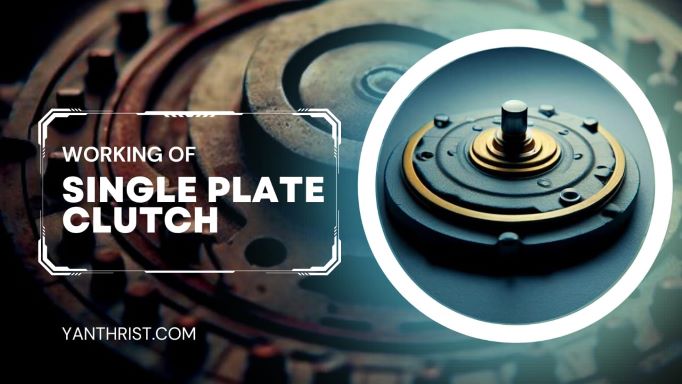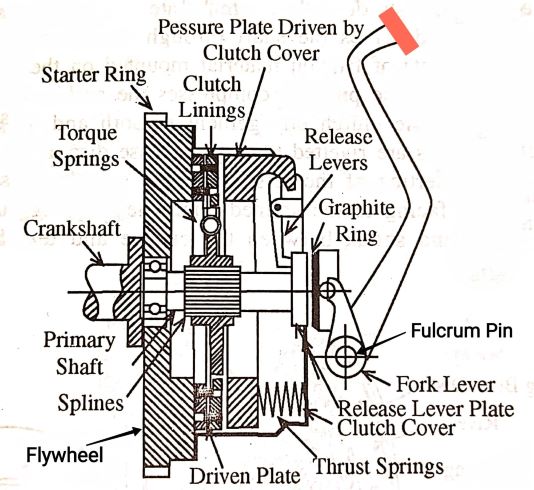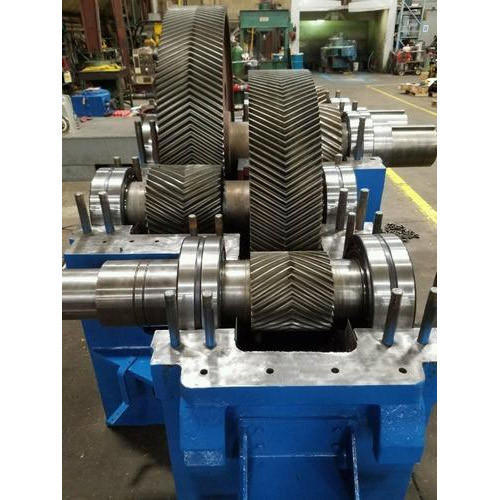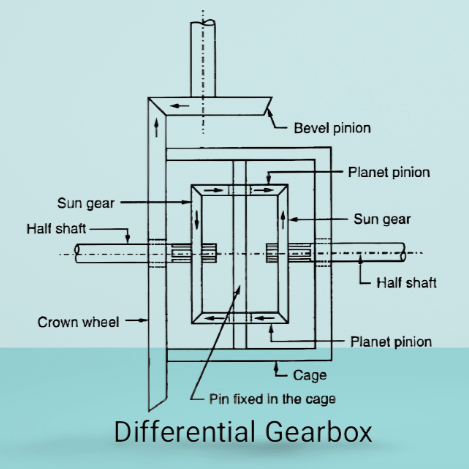The purpose of this article is to provide an informative overview of single plate clutches. It aims to explain the construction, working principle, advantages, and disadvantages of single plate clutches. Additionally, it highlights the importance and applications of single plate clutches in various industries. The article also covers maintenance, troubleshooting, and future developments in clutch technology. The information provided serves as a comprehensive guide for readers seeking knowledge about single plate clutches, their functionality, and their significance in different sectors.
Table of Contents

WHAT IS CLUTCH?
A clutch system is a mechanical device that enables the connection and disconnection of power transmission between the engine and the transmission of a vehicle or machinery. Its primary purpose is to facilitate smooth engagement and disengagement of the engine from the drivetrain, allowing for gear changes and control over power delivery. By disconnecting the engine from the transmission, the clutch system enables the vehicle to come to a stop without stalling the engine and allows for shifting between different gears.
A single plate clutch is a type of friction clutch commonly used in various industries. It consists of a single clutch plate sandwiched between the flywheel and the pressure plate. When engaged, the clutch plate is pressed against the flywheel, transmitting power from the engine to the transmission. Disengaging the clutch separates the clutch plate from the flywheel, interrupting power transmission.
The single plate clutch holds significant importance in a wide range of industries, including:
- Automotive industry: Single plate clutches are extensively used in cars, trucks, and other vehicles. They enable smooth gear changes, efficient power transmission, and provide control over the vehicle’s motion.
- Industrial machinery: Many industrial machines, such as construction equipment, agricultural machinery, and manufacturing machinery, rely on single plate clutches for power transmission and control.
- Agriculture equipment: Tractors and other agricultural machinery often utilize single plate clutches. They allow farmers to efficiently control the power delivery and operate various agricultural implements.
- Motorcycles and recreational vehicles: Single plate clutches are commonly found in motorcycles and other recreational vehicles, enabling riders to change gears smoothly and control the power output.
The application of single plate clutches in these industries ensures reliable power transmission, smooth engagement and disengagement, and precise control over the machinery or vehicle’s operation.
Components of Single plate clutch
A single plate clutch is a type of friction clutch that consists of several components working together to transmit power between the engine and the transmission. The construction and components of a single plate clutch include:

1. Engine Shaft:
The engine shaft, also known as the input shaft, connects the clutch assembly to the engine’s output. It transfers power from the engine to the clutch.
2. Flywheel:
The flywheel is a large, heavy disc connected to the engine’s crankshaft. It provides a smooth and rigid surface for the clutch assembly to engage with.
3. Friction Lining:
The clutch plate contains a friction lining, typically made of materials such as organic or ceramic, which provides the necessary grip and friction to transmit power. The friction lining is attached to both sides of the clutch plate.
4. Clutch Plate:
The clutch plate, also known as the friction disc, is the central component of the clutch assembly. It is a flat circular plate with friction material (typically made of composite material) attached to both sides. The clutch plate is splined to the transmission input shaft and rotates with it.
5. Spring:
The spring, also known as the diaphragm spring, is located behind the pressure plate. It applies a constant force to the pressure plate, maintaining the engagement of the clutch. The spring helps in smooth disengagement and re-engagement of the clutch.
6. Pressure Plate:
The pressure plate is a circular metal plate that is bolted to the flywheel. It exerts pressure on the clutch plate, forcing it against the flywheel. The pressure plate has a release mechanism that allows it to move away from the clutch plate when the clutch is disengaged.
7. Clutch Cover:
The clutch cover, also known as the clutch housing or clutch basket, encloses the clutch assembly. It provides protection and support for the clutch components. The clutch cover is bolted to the flywheel and houses the pressure plate.
8. Clutch Springs:
Clutch springs are coil springs that are mounted on the pressure plate. These springs exert force on the pressure plate, maintaining pressure on the clutch plate when the clutch is engaged. The springs help ensure proper engagement and provide some degree of cushioning during engagement.
9. Release Mechanism:
The release mechanism consists of a release lever and a release bearing (also called a throw-out bearing). The release lever is connected to the clutch pedal through a linkage system. When the clutch pedal is pressed, it moves the release lever, which in turn moves the release bearing against the pressure plate. This action releases the pressure on the clutch plate, disengaging the clutch.
10. Clutch Pedal:
The clutch pedal is located inside the vehicle’s cabin and is operated by the driver’s foot. Depressing the clutch pedal disengages the clutch, allowing for gear changes or stopping the vehicle without stalling the engine.
11. Fulcrum Pin:
The fulcrum pin acts as a pivot point for the release lever. It allows the release lever to move freely and transmit force to the release bearing.
These components work together to engage and disengage the clutch, enabling the transmission of power from the engine to the transmission when engaged and interrupting power transmission when disengaged. The friction between the clutch plate and the flywheel allows for power transfer, while the pressure plate and clutch springs ensure proper contact and sufficient pressure for efficient power transmission.
Single Plate Clutch WORKING in Engaged and Disengaged Condition
A. Engaged Condition:
- When the clutch is in the engaged condition, the clutch pedal is released, and the pressure plate exerts pressure on the clutch plate.
- The engine’s rotation is transmitted to the input shaft of the transmission through the clutch plate.
- Frictional forces between the clutch plate’s friction lining and the flywheel allow for power transfer from the engine to the transmission.
- The pressure plate, which is connected to the flywheel, maintains constant pressure on the clutch plate, ensuring efficient power transmission.
B. Disengaged Condition:
- When the clutch pedal is pressed, the release mechanism is activated, and the pressure on the clutch plate is released.
- The release lever, connected to the clutch pedal, applies force to the release bearing.
- The release bearing pushes against the pressure plate, causing it to move away from the clutch plate.
- As a result, the clutch plate is disengaged from the flywheel, interrupting power transmission.
- With the clutch disengaged, the engine and transmission are decoupled, allowing for gear changes or the vehicle to come to a stop without stalling the engine.
YOU CAN ALSO CHECK Fuel Supply Governing Methods in I.C. Engines.
Single Plate Clutch Formula
The single plate clutch formula is used to calculate the torque transmitted by the clutch. The formula is as follows:
T = (µ × R × F) / R1
Where:
T = Torque transmitted by the clutch.
µ = Coefficient of friction between the clutch plate and flywheel.
R = Radius of the contact surface between the clutch plate and flywheel.
F = Force applied by the pressure plate on the clutch plate.
R1 = Radius of the pressure plate.
Maximum torque transmitted by single plate clutch for Uniform pressure Theory:-
T= 2/3×μ×W[(R13−R23)/(R12−R22)]
W = Axial thrust on the plates
R1 = Outside radius of friction surface.
R2 = Inner radius of the friction surface
μ = Co-efficient of friction
Maximum torque transmitted by single plate clutch by Uniform wear Theory:-
T= 12×μ×W(R1+R2)
Types of Single Plate Clutch:
Helical Spring Type Single Plate Clutch:
In this type of single plate clutch, a set of helical springs is used to exert pressure on the pressure plate. The springs are mounted around the hub of the pressure plate, providing the required force to engage the clutch. Helical spring clutches are known for their smooth engagement and disengagement, making them suitable for various applications.
Diaphragm Spring Type Single Plate Clutch:
In a diaphragm spring type single plate clutch, a diaphragm spring replaces the coil springs used in the helical spring clutch. The diaphragm spring is a conical-shaped spring that acts as both the pressure plate and the release mechanism. It applies pressure on the clutch plate when engaged and flexes to disengage the clutch when the pedal is pressed. Diaphragm spring clutches are compact, lightweight, and provide a higher clamping force compared to helical spring clutches.
Both types of single plate clutches operate based on the same fundamental principles, but they differ in the design of the spring mechanism used for engagement and disengagement. The choice between these types depends on factors such as application requirements, torque capacity, and desired performance characteristics.
Advantages of Single Plate Clutch
Single plate clutches offer several advantages, which contribute to their widespread use in various industries. Here are some of the key advantages of single Plate Clutch:
- Compact and Lightweight Design: Single plate clutches have a simpler construction compared to multiplate clutches, resulting in a more compact and lightweight design. This makes them suitable for applications where space and weight are crucial factors, such as in automotive vehicles and motorcycles.
- Smooth Engagement and Disengagement: Single plate clutches offer smooth engagement and disengagement, providing a more comfortable driving experience. The use of a single friction plate ensures a uniform and consistent engagement, leading to smoother shifting and reduced transmission shock.
- Efficient Power Transmission: Single plate clutches have a high power transmission efficiency due to the direct engagement between the clutch plate and flywheel. The simplicity of the design and the use of friction materials with high coefficient of friction contribute to efficient power transfer.
- Cost-effective and Easy to Maintain: Single plate clutches are generally more cost-effective compared to multiplate clutches. They have fewer components, making them easier to manufacture and maintain. The simplicity of the design also facilitates easier inspection, replacement, and repair of clutch components.
Comparison with Other Clutches
When comparing single plate clutches with other types of clutches, such as multi plate clutches, there are a few notable differences:
- Torque Capacity: Single plate clutches typically have a lower torque capacity compared to multiplate clutches. Multiplate clutches, with their multiple clutch plates, can handle higher torque loads, making them suitable for heavy-duty applications like high-performance vehicles and industrial machinery.
- Size and Weight: Single plate clutches are more compact and lightweight than multiplate clutches. This makes them advantageous in applications where space and weight constraints are important considerations.
- Complexity: Single plate clutches have a simpler design and fewer components compared to multiplate clutches. This simplicity contributes to easier installation, maintenance, and repair, as well as cost savings in terms of manufacturing and replacement parts.
- Engagement Characteristics: Single plate clutches provide smoother engagement and disengagement due to the use of a single friction plate. Multiplate clutches, on the other hand, may exhibit a more abrupt engagement due to the multiple plates interacting with each other.
Overall, single plate clutches offer a balance between compactness, simplicity, and smooth operation, making them suitable for a wide range of applications where moderate torque capacity and efficient power transmission are required.
Disadvantages of Single Plate Clutch
While single plate clutches offer several advantages, they also have some limitations and disadvantages that should be taken into consideration. Here are some disadvantages of single plate clutches compared to other clutch types:
- Limited Torque Capacity: Single plate clutches have a lower torque capacity compared to multi-plate clutches. Multi-plate clutches consist of multiple clutch discs interleaved with friction linings, allowing them to handle higher torque loads. In high-performance applications or heavy-duty machinery, where high torque is required, a multi-plate clutch may be more suitable.
- Higher Risk of Heat Generation: Single plate clutches have a higher tendency to generate heat compared to some other clutch types. The single friction surface of a single plate clutch may experience increased temperatures during operation, leading to thermal degradation and reduced clutch life. In contrast, multi-plate clutches with their larger surface area can dissipate heat more effectively.
- Reduced Durability under Heavy Loads: Under heavy loads, single plate clutches are more prone to wear and damage compared to multi-plate clutches. The limited contact area of a single plate clutch can cause higher pressure and wear on the friction lining, resulting in reduced longevity. Multi-plate clutches distribute the load across multiple discs, reducing wear and increasing durability.
- Slower Engagement and Disengagement: Single plate clutches generally have slower engagement and disengagement times compared to some other clutch types, such as dual-clutch systems. Dual-clutch systems utilize separate clutch packs for odd and even gears, allowing for rapid and seamless gear changes. In applications where fast shifting is critical, single plate clutches may not offer the same level of performance.
- Less Control in High-Performance Applications: In high-performance applications, where precise control over power delivery is essential, single plate clutches may not provide the same level of control as advanced clutch systems like electronically controlled clutches or torque vectoring differentials. These advanced systems can modulate torque distribution more precisely, enhancing performance and handling characteristics.
Single plate clutches may have certain limitations, they are still widely used in various industries due to their cost-effectiveness, simplicity, and suitability for many applications. Ultimately, the choice of clutch type depends on the specific needs, torque requirements, and performance expectations of the application.
Application of Single Plate Clutch
Single plate clutches find application in various industries and systems where power transmission is necessary. Some common application of single plate clutches include:
- Automotive Industry: Single plate clutches are widely used in automobiles, including passenger cars, trucks, and commercial vehicles. They enable smooth engagement and disengagement of the engine from the transmission, allowing for gear changes, starting and stopping the vehicle, and idle operation.
- Industrial Machinery: Single plate clutches are employed in various industrial machinery, such as generators, pumps, compressors, and machine tools. They facilitate power transmission between the engine or motor and the driven equipment, enabling efficient operation and control.
- Agriculture Equipment: Many agricultural machines, including tractors, harvesters, and irrigation systems, utilize single plate clutches. These clutches allow for power transfer from the engine to the implements or auxiliary systems, enabling the performance of various agricultural tasks.
- Motorcycles and Recreational Vehicles: Single plate clutches are extensively used in motorcycles, scooters, and other two-wheeled vehicles. They enable gear changes, starting, and stopping of the vehicle. Additionally, single plate clutches can be found in recreational vehicles, such as ATVs (all-terrain vehicles) and snowmobiles, providing power transmission for propulsion.
- Industrial Power Transmission Systems: Single plate clutches are employed in various power transmission systems, including conveyor systems, industrial pumps, and manufacturing machinery. They enable the controlled transfer of power from the prime mover to the driven equipment, facilitating efficient operation and control.
- Marine Applications: In marine propulsion systems, single plate clutches are used to connect the engine to the propeller shaft. They allow for smooth engagement and disengagement of the engine from the propulsion system, enabling speed control, forward and reverse operation, and maneuverability.
The versatility and effectiveness of single plate clutches make them suitable for a wide range of industries and systems where controlled power transmission is required.
Maintenance and Troubleshooting
Maintenance and troubleshooting are crucial aspects of ensuring the proper functioning and longevity of a single plate clutch. Here are some guidelines for maintenance and common troubleshooting techniques:
Maintenance:
- Regular Inspection: Perform periodic visual inspections of the clutch components, including the clutch plate, pressure plate, release bearing, and linkage. Look for signs of wear, damage, or misalignment.
- Lubrication: Ensure that the clutch release mechanism, such as the release lever and fulcrum pin, are properly lubricated to minimize friction and ensure smooth operation.
- Clutch Pedal Adjustment: Check the clutch pedal free play and adjust it as necessary to ensure proper engagement and disengagement of the clutch. Excessive or insufficient free play can lead to clutch slippage or difficulty in shifting gears.
- Friction Lining Condition: Inspect the friction lining on the clutch plate for wear. If the lining is excessively worn, it may need to be replaced to maintain optimal clutch performance.
- Fluid Check: If your vehicle has a hydraulic clutch system, check the fluid level regularly and ensure that it is within the recommended range. Top up or replace the fluid if necessary.
Troubleshooting:
- Clutch Slippage: If you experience clutch slippage, where the engine revs increase without a proportional increase in vehicle speed, it could indicate worn friction lining or insufficient pressure on the clutch plate. Consult a professional mechanic to assess the clutch and make necessary adjustments or replacements.
- Difficult Shifting: Difficulty in shifting gears, such as stiff or grinding gear changes, may indicate issues with the clutch linkage, release mechanism, or improper clutch adjustment. Inspect and adjust the clutch linkage or seek professional assistance to resolve the issue.
- Clutch Noise: Unusual noises when engaging or disengaging the clutch, such as grinding or squealing sounds, could indicate a worn release bearing or misalignment of clutch components. Promptly address the issue by replacing the faulty component or realigning the clutch.
- Clutch Drag: If the clutch does not fully disengage when the pedal is pressed, resulting in difficulty in shifting gears or gear clash, it could be due to insufficient release bearing travel or air in the hydraulic clutch system (if applicable). Bleeding the clutch system or adjusting the release mechanism may resolve the problem.
- Pedal Vibrations: Excessive pedal vibrations during clutch operation could indicate a worn or damaged clutch disc, misalignment, or imbalanced components. Have a professional inspect and diagnose the cause of the vibrations for appropriate repairs or replacements.
Future Developments and Alternatives
Future Developments and Alternatives in Clutch Technology:
- Dual-Clutch Systems and Automated Manual Transmissions: Dual-clutch systems offer faster and smoother gear shifts by using two separate clutches for odd and even gears. This technology eliminates the need for a traditional clutch pedal, as the shifting is controlled electronically. Automated manual transmissions combine the efficiency of manual transmissions with the convenience of automatic shifting. These advancements improve overall driving experience, fuel efficiency, and performance.
- Electromagnetic Clutches: Electromagnetic clutches utilize the principles of electromagnetism to engage and disengage the clutch. They offer precise control over the clutch engagement, allowing for faster response times and improved efficiency. Electromagnetic clutches find applications in various industries, including automotive, robotics, and industrial machinery.
- Continuously Variable Transmissions (CVTs): CVTs provide seamless and continuous gear ratio changes, eliminating the need for discrete gears. Instead, they use a system of belts or chains and variable-diameter pulleys to vary the gear ratio. CVTs offer improved fuel efficiency and smoother acceleration compared to traditional transmissions.
- Hybrid and Electric Vehicle Technologies: With the increasing focus on sustainable transportation, hybrid and electric vehicles are gaining popularity. These vehicles often utilize alternative methods of power transmission, such as electric motors or hybrid systems that combine internal combustion engines with electric motors. Such systems may incorporate clutches or other devices to manage power transfer between different power sources.
- Advanced Friction Materials: Ongoing research and development efforts focus on improving the friction materials used in clutches, aiming to enhance durability, thermal resistance, and performance. Advanced friction materials can provide better engagement characteristics, reduce wear, and increase the torque capacity of clutches.
- Integration of Sensors and Electronics: Advancements in sensor technology and electronics allow for better monitoring and control of clutch systems. Sensors can provide real-time feedback on clutch engagement, temperature, wear, and other parameters, enabling predictive maintenance and optimizing clutch performance.
These future developments and alternatives aim to enhance the efficiency, performance, and durability of clutches while addressing the evolving needs of various industries and emerging technologies. As technology continues to advance, the clutch systems are likely to evolve further, offering improved functionality and seamless integration with modern powertrain systems.
Conclusion
The single plate clutch is a crucial component in power transmission systems, offering compact design, smooth engagement and disengagement, efficient power transmission, and cost-effectiveness. It is used in various industries, including automobiles, industrial machinery, agriculture equipment, motorcycles, and recreational vehicles. There are two common types: helical spring and diaphragm spring. However, single plate clutches have limitations, such as limited torque capacity, slipping under heavy loads, and heat generation issues. Proper maintenance and regular inspections are essential for optimal performance. Future developments in clutch technology include dual-clutch systems, electromagnetic clutches, continuously variable transmissions, hybrid and electric vehicle integration, friction materials, sensors, electronics, and ongoing research.
FAQ
1. Why are heavy vehicles made with a single plate clutch?
Heavy vehicles, such as trucks and commercial vehicles, are often equipped with single plate clutches due to several reasons:
- Cost and Simplicity: Single plate clutches are generally more cost-effective and simpler in design compared to multiplate clutches. Heavy vehicles require robust and durable components, and single plate clutches provide a reliable and cost-efficient solution.
- Torque Capacity: Single plate clutches can handle substantial torque loads, making them suitable for heavy-duty applications. Although multiplate clutches have higher torque capacity, single plate clutches are often sufficient for heavy vehicles.
- Ease of Maintenance: Single plate clutches are easier to maintain and repair compared to multiplate clutches. The simplicity of the design allows for quicker and more straightforward maintenance procedures, reducing downtime for heavy vehicles.
2. Why are single plate clutches dry?
Single plate clutches are often designed as dry clutches, meaning they do not require any form of lubrication or immersion in fluids. The main reasons for using dry clutches are:
- Efficiency: Dry clutches have less parasitic loss compared to wet clutches, as there is no drag caused by fluid immersion. This results in better power transfer efficiency.
- Simplified Design: Dry clutches have a simpler construction since they do not involve fluid circulation systems, such as pumps and coolers, found in wet clutches. This simplification makes them more compact, lightweight, and easier to manufacture and maintain.
- Reduced Complexity: The absence of fluids eliminates the need for fluid changes, seals, and potential leaks associated with wet clutches, reducing maintenance requirements and overall complexity.
3. Why is a single plate clutch more effective than a multi plate clutch?
While both single plate and multi plate clutches have their advantages and specific applications, single plate clutches offer several advantages that make them more effective in certain contexts:
- Compactness and Weight: Single plate clutches have a simpler and more compact design, resulting in reduced size and weight compared to multiplate clutches. This makes them suitable for applications where space and weight constraints are important factors.
- Smooth Engagement: Single plate clutches provide smoother engagement due to the direct interaction between the single friction plate and the flywheel. This results in improved shifting characteristics and reduced transmission shock.
- Cost-effectiveness: Single plate clutches are generally more cost-effective to manufacture, maintain, and repair compared to multiplate clutches. Their simpler design and fewer components contribute to cost savings.


